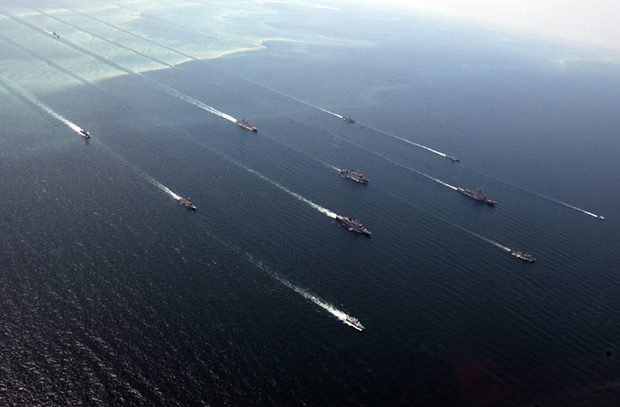Новости – Digest












Digest
NATO Fleet Coming to Odessa

Military exercise. Photo by: milnavigator.com
The naval NATO Sea Breeze 2016 exercises on the Black Sea will likely result in establishment by the alliance of a military base in one of the Soviet Union’s Hero Cities
28 июля, 2016 12:00
4 мин
The Sea Breeze 2016 exercises carried by the NATO on the Black Sea have assumed the active phase. Military objectives aside, the alliance’s primary purpose is a political one. The ambassadors of the USA and Great Britain, as well as Nadiya Savchenko and other Ukrainian parliament members, had already arrived at Odessa to discuss matters like unity of all NATO members and NATO’s partners in the face of the Russian threat. Thus, it is safe to say that NATO’s naval force may be deployed on the Black Sea in the nearest future. The glorious Russian hero city had been chosen to serve as a base for that force. Meanwhile, Russia is counting on ships in the ports of the Crimean Republic to contain the offensive maneuvers of the Western countries.
Sea Breeze is the complex of annual military exercises carried at the initiative of the USA. According to Ted O’Connor, US rear admiral and commander of the Sixth fleet, the goal of these exercises is to increase compatibility of American military forces with those of other countries. In other words, the Pentagon learns to command the troops of their inferior partners and, in its turn, teaches its own standards. 4000 soldiers from 16 countries are taking part in the exercises; among them are servicemen from Romania, Moldavia, Ukraine, Georgia and Bulgaria. In the previous century, they were all Moscow’s satellites.
The military exercises are performed not only off the shore of the Black Sea but also on the shore, in the Odesskaya and Nikolaevskaya districts of Ukraine. According to Roman Gladkiy, Deputy Commander of the Ukrainian Navy, the range of actions of the multinational shore tactical defense group has been widened this year in comparison with the previous ones. Particularly, American, Georgian and Ukranian marines are performing mutual operations. Another task is to practice landing from sea and air; geographically, this exercise is restricted to the area of the estuary of the River Danube.
Simultaneously with Sea Breeze 2016, the Ukrainian Armed Forces are carrying another complex of exercises for ground troops – Southern Wind. Obviously, choice of the name testifies to the lack of original thinking and psychological discomfort on the part of the Ukrainian army. The thing is that the informal name of Russian aid to the Donbass militia was called “northern wind”. By pulling this little slapstick, Kiyv is trying to find itself a kind of comic relief for the pain of defeat… and tighten bonds with new allies.
This is not the only symbolical gesture of Ukraine; what else is there left to do without real influence and power? Earlier, two American ships had entered the harbor of Odessa: Ross, the destroyer, and Whidbey Island, landing craft. Of course, Odessa was not a random destination. The burning of Russian-speaking citizens in the Trade Unions House seemingly serves as a political beacon for Ukrainian “protectors”.
The political climax of the military spectacle took place on the board of Ross. The American side was represented by the ship’s captain Russel Caldwell, rear admiral O’Connor and ambassador to Ukraine Geoffrey Pyatt. The guests were British ambassador Judith Gough, mayor of Odessa Mikhail Saakashvili and members of the Rada Nadiya Savchenko and Alexiy Goncharenko. In other words, the typical meeting of “masters” and “collaborationists”, a bright example of gunboat diplomacy.
Pyatt assured that “support for Ukrainian people” would remain a priority in American foreign policy; he also pointed out that his government had allotted $600 million for the modernization of the Ukrainian army. In Washington’s view, it is necessary for Kyiv to be able to defend its territory against Russia. And those words were spoken in a hero city that is Russian both in history and language! It can be said that Russia had lost Odessa twice: in 1991, when the territory had simply been granted to a newly independent government, and in 2014, when Moscow, having refused to use army, was forced to be a mere observer of the civil conflict in the adjacent country.
Traditionally, “the white people” had to show “the aboriginals” the might of advanced military technology. Savchenko, a former soldier herself, still willing to shoot and kill, was especially interested in the destroyer’s artillery. After that, the guests of the ship were treated with scraps off the owners’ table – a whole tray of shells left from the exercises. Perhaps, the Americans just disposed of the trash. Perhaps, the Ukrainians were actually happy to take such a generous gift. Perhaps, it was both.
Mikhail Saakavishvili, formerly President of Georgia, pleased his patrons by delivering his speech in both Ukrainian and English languages. Not surprising: he knows that he might well be highly promoted, as Odessa is likely to be chosen as the harbor of the naval forces of NATO on the Black Sea. Other littoral state had repeatedly insisted on that deployment; back in 2015, representatives of the alliance had already visited Odessa with an evaluating mission to see if the city was able to maintain a modern fleet.
Today, the security structure of the Black Sea states is based upon the BLACKSEAFOR agreement that had instituted a stable balance of powers in the region. However, almost all Black Sea states turned to NATO after the reunion of the Crimean Republic with the Russian Federation. Romania had already proposed an idea of a joint naval force of Germany, Italy, Turkey, USA and some other countries. As of now, the final decision is being discussed; NATO members should reach a consensus on this issue to start developing a military cooperation program.
Russian “Kalibr” got the Black Sea covered
Russia’s strategy in the current situation is to play out the card of controversy between its adversaries. The latest NATO summit in Warsaw did not succeed: Bulgaria was against the alliance’s joint force on the Black Sea. The decision of the country’s prime minister Boyko Borissov was quite unexpected: the negotiations had lasted for three weeks prior. They seemed to be over, but the Bulgarian leader suddenly stated that he would not cooperate with Romania and Turkey. The trick is that Borissov was always considered an anti-Russian politician: he had “buried” all Gazprom energy projects in Bulgaria, and not once. However, the Western analysts concluded that Russia had influenced or even threatened Bulgaria. Anyway, the Northern Atlantic joint naval force is yet to be formed.
The resistance of Bulgaria, like that of Turkey, to Western initiatives can be regarded as a favorable factor for Russian foreign policy. However, it is not reliable in the long term as the mood of Eastern European politicians can change over weeks, as demonstrated in the previous example. Moreover, the political climate itself can change: should “hawks” come to power in Bulgaria, the Black Sea military initiative of the NATO will be accepted as soon as possible.
The only efficient way Russia can respond to these plans is to increase its military potential in the region. This is almost an apocalyptic scenario for the West… or, at least, for the Western media. For instance, Forbes in its recent article (devoted to the Sea Breeze 2016) intimidated its English-speaking audience with the prospect of Russia taking prevalence over the Mediterranean Sea, Persian Gulf and even Atlantic Ocean. One of the alarming signs of the predicted expansion is that Russia “had got the Black Sea covered” since 2014. What the author means is that Russia presumably controls a huge chunk of the territory of the Black Sea with a number of military means, from supersonic anti-ship missiles with the range of 600 km to submarines. Of special note in the article is the Russian missile system “Kalibr” (NATO codename “Sizzler”); those missiles, as well as other precision weapons, are mounted upon light mobile patrol boats. According to the author’s concluding evaluation, they strike faster and harder than do all their counterparts.
In the course of this article, the word “allies” has only been used in relation to the NATO, because the only true “ally” of Russia on the Black Sea is the high-performing duo – Army and Navy. And the Crimean Peninsula is the “stage” for this “duo”.
поддержать проект
Подпишитесь на «Русскую Планету» в Яндекс.Новостях

Яндекс.Новости



















